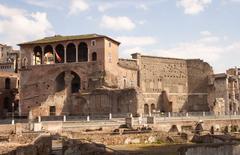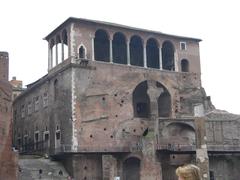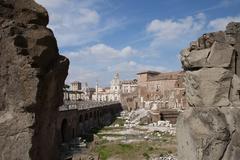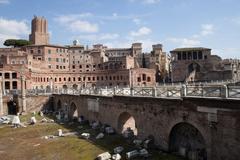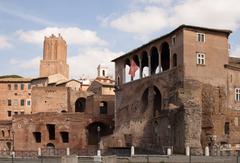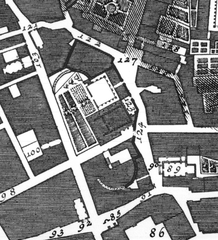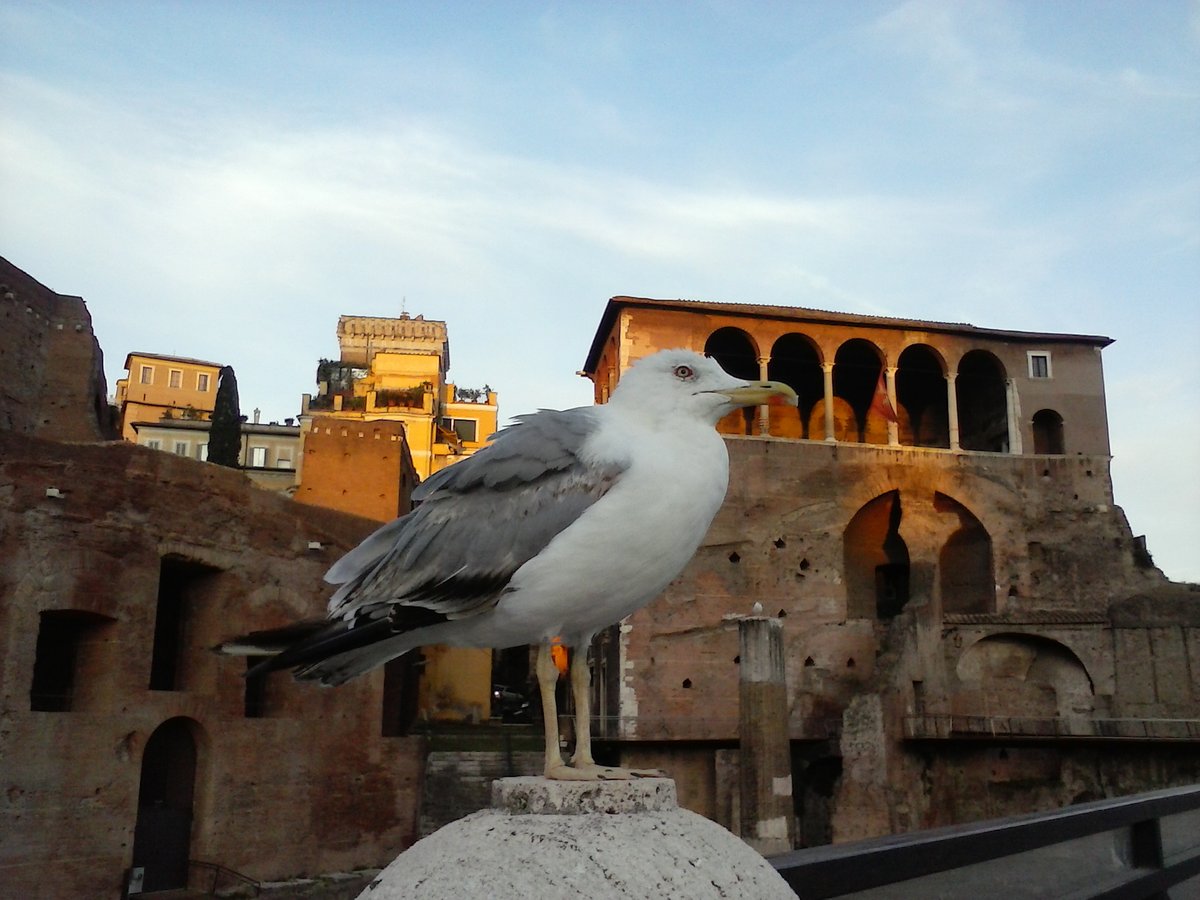
Casa dei Cavalieri di Rodi: Visiting Hours, Tickets, and Historical Significance in Rome
Date: 14/06/2025
Introduction
Nestled above the ancient Forum of Augustus, the Casa dei Cavalieri di Rodi (House of the Knights of Rhodes) stands as one of Rome’s most unique and evocative monuments. Fusing Roman imperial foundations with medieval and Renaissance architectural flourishes, the Casa offers a compelling journey through centuries of religious, military, and artistic evolution. Once the Roman priory of the Knights Hospitaller—later the Knights of Malta—the building today holds a special place in Rome’s cultural landscape, accessible primarily through exclusive guided tours. This guide presents essential information on the Casa dei Cavalieri di Rodi’s visiting hours, ticketing, accessibility, historical significance, and practical tips for an unforgettable experience at this storied site.
For official details and the latest visitor information, consult the Sovereign Military Order of Malta’s official site, Roma.com, and Turismo Roma.
Table of Contents
- Introduction
- Historical Overview
- Architectural and Artistic Highlights
- Visiting the Casa dei Cavalieri di Rodi
- Nearby Attractions
- Cultural and Symbolic Significance
- Special Events and Photography
- Frequently Asked Questions (FAQ)
- Conclusion and Recommendations
- Contact and Further Information
- References
Historical Overview
Ancient and Medieval Foundations
Rising directly above the Forum of Augustus, the Casa dei Cavalieri di Rodi’s earliest layers are intertwined with ancient Rome. Its foundations incorporate remnants of the Temple of Mars Ultor, built by Emperor Augustus to celebrate victory at Philippi. In the 9th century, monks constructed a church and a monastery dedicated to San Basilio on this site, utilizing stonework from the ancient ruins. The medieval complex’s integration with Roman-era architecture makes it a rare example of continuous urban evolution (Turismo Roma; Rome Roma.net).
By the early 13th century, the Knights Hospitaller—an order dedicated to St. John the Baptist—acquired the property, transforming it into their Roman headquarters and a fortified residence (Rome.us; Roma.com).
The Arrival of the Knights of Rhodes
The Knights Hospitaller, often called the Knights of Rhodes, played a central role in medieval religious and military history. Their presence in Rome was marked by the conversion of the Casa into a priory, serving as a base for their charitable, diplomatic, and defensive missions. The building’s strategic location overlooking the Imperial Fora underscored the order’s influence and commitment to the city (Roma.com; Visite Guidate Roma).
Renaissance and Later Modifications
During the Renaissance, the Casa underwent significant transformations. In the late 15th century, Cardinal Marco Barbo, nephew of Pope Paul II, commissioned a major restoration—bestowing upon the building its iconic eight-arched loggia, which remains one of its most celebrated features. The interiors received lavish decorative programs, including frescoes, wooden coffered ceilings, and heraldic motifs reflecting the order’s prestige (Nonsolo Turisti; Rome Roma.net).
In the 17th century, the property was adapted for use by Dominican nuns of the SS. Annunziata, until the convent’s demolition in the early 20th century for urban redevelopment (Turismo Roma; Sovrintendenza Capitolina).
Restoration and Modern Use
Following extensive restoration by the Municipality of Rome in the mid-20th century, the Casa dei Cavalieri di Rodi was returned to the Sovereign Military Order of Malta in 1946. Today, it functions as a representative seat of the Order and is open to the public exclusively via guided tours (Wikipedia; Turismo Roma).
Architectural and Artistic Highlights
The Renaissance Loggia
The Casa’s loggia is its architectural showpiece, offering panoramic vistas over the Forum of Augustus and the wider Imperial Fora. Its eight travertine arches, slender columns, and decorative capitals exemplify Renaissance elegance and provide a ceremonial platform once used for papal blessings. Faded frescoes—possibly by artists from Andrea Mantegna’s school—adorn the loggia, depicting imperial medallions and landscapes (Sovrintendenza Capitolina; Visite Roma Sotterranea).
Interior Halls and Chapel
Key interior spaces include:
- Salone d’Onore (Hall of Honor): Showcases heraldic flags, coffered ceilings, and period frescoes, used historically for ceremonies and gatherings.
- Sala Bizantina (Byzantine Room): Features medieval frescoes and woodwork, evoking the building’s monastic origins.
- Sala della Loggetta: Houses reconstructed elements from the Forum of Augustus, along with sculptures and paintings from various eras.
- Cappella Palatina: Located on the underground level, this chapel dedicated to St. John the Baptist is set within the ancient atrium of a Roman residence, reflecting the site’s complex stratification (Turismo Roma; Rome Roma.net).
Visiting the Casa dei Cavalieri di Rodi
Visiting Hours
The Casa dei Cavalieri di Rodi is not open for daily public visits. Access is strictly limited to guided tours, generally offered on Tuesday and Thursday mornings, with group sizes capped at 25 to ensure a tranquil atmosphere. Visiting hours are subject to change and are coordinated by the venue or authorized cultural associations (Turismo Roma).
Tickets and Booking
- Advance Booking: Required for all visits. Reservations are made by calling 060608 (daily, 9:00–19:00) or through authorized tour operators.
- Ticket Prices: Vary by type of tour. Standard group visits are around €4 per person; special tours (e.g., sunset visits with aperitif) may range from €10 to €20 (Esperide; Turistipercaso.it).
- Capacity: Groups are limited to preserve the site.
Guided Tours
Guided tours last 60–75 minutes and cover the main halls, loggia, and chapel. Most tours are in Italian, but some operators may offer English-language options on request. Tours provide rich historical context and reveal details not accessible to independent visitors (Rome.us; Roma Guida).
Accessibility
Due to the building’s historic structure, accessibility is limited—there are stairs, uneven surfaces, and no elevator. Visitors with mobility needs should contact the venue or tour operator in advance for up-to-date advice (Turismo Roma; Roma Accessibile).
Travel Tips
- Book Early: Openings are limited and tours fill quickly, especially during peak seasons.
- Combine Visits: Its central location allows easy access to the Forum of Augustus, the Roman Forum, and Capitoline Hill.
- Photography: Allowed in most areas, but ask your guide about potential restrictions, especially around delicate frescoes.
- Facilities: There are no cafes or shops on-site; plan accordingly.
Nearby Attractions
- Forum of Augustus
- Roman Forum
- Mercati di Traiano (Trajan’s Market)
- Capitoline Hill and Museums
- Piazza Venezia
These sites are all within walking distance and offer a broader context for understanding Rome’s ancient and medieval history.
Cultural and Symbolic Significance
The Casa dei Cavalieri di Rodi is more than a historical building; it is a living symbol of the Knights Hospitaller’s enduring legacy in Rome. Its layered history—from Roman insula to a monastic center and knightly residence—mirrors the city’s transformation over the millennia. The Casa is also renowned in Italian popular culture as a filming location for the beloved film “Il Marchese del Grillo” (Turistipercaso.it).
Special Events and Photography
Occasionally, the Casa hosts special events—such as evening tours or cultural gatherings—organized by the Knights of Malta or local associations. These may offer additional access or interpretive experiences. Photography is generally permitted (no flash or tripods in sensitive areas), making the loggia a particularly prized spot for capturing Rome’s ancient heart.
Frequently Asked Questions (FAQ)
What are the visiting hours?
Visits are available by guided tour only, usually on Tuesday and Thursday mornings. Confirm current schedules when booking.
How do I book tickets?
Reserve in advance by calling 060608 or through authorized tour operators. Walk-in visits are not permitted.
Is the site accessible for people with disabilities?
Accessibility is limited. Consult the venue in advance for advice.
Are guided tours mandatory?
Yes, all visits are guided.
Can I take photos inside?
Photography is generally permitted except where restricted for preservation reasons.
What can I see inside the Casa?
Tours include the Salone d’Onore, Sala Bizantina, Sala della Loggetta, the loggia with panoramic views, and the underground palatine chapel.
Conclusion and Recommendations
The Casa dei Cavalieri di Rodi offers a rare and intimate insight into Rome’s imperial, medieval, and Renaissance past, far from the bustling crowds. Its exclusive access via guided tours preserves its unique atmosphere, and the panoramic views from the loggia are among the city’s finest. Book in advance, combine your visit with nearby attractions, and immerse yourself in the fascinating legacy of the Knights Hospitaller in the heart of the Eternal City.
For further tips, updates on special events, and to enhance your travels in Rome, download the Audiala app and follow our channels for insider advice.
Contact and Further Information
- Official Website: Sovrintendenza Capitolina
- Tour Booking: Esperide, Roma Guida
- General Info: Turismo Roma
Tip: Enhance your experience by exploring high-quality images of the loggia’s panoramic views, artistic interiors, and the Palatine Chapel. For those unable to visit in person, check for virtual tours or interactive maps on official websites.
References
- Visite Guidate Roma
- Roma.com
- Nonsolo Turisti
- Rome Roma.net
- Visite Roma Sotterranea
- Turismo Roma
- Roma Guida
- Rome.us
- Esperide
- Il Turista
- I Viaggi di Raffaella
- Wikipedia
- Sovrintendenza Capitolina
- Turistipercaso.it

